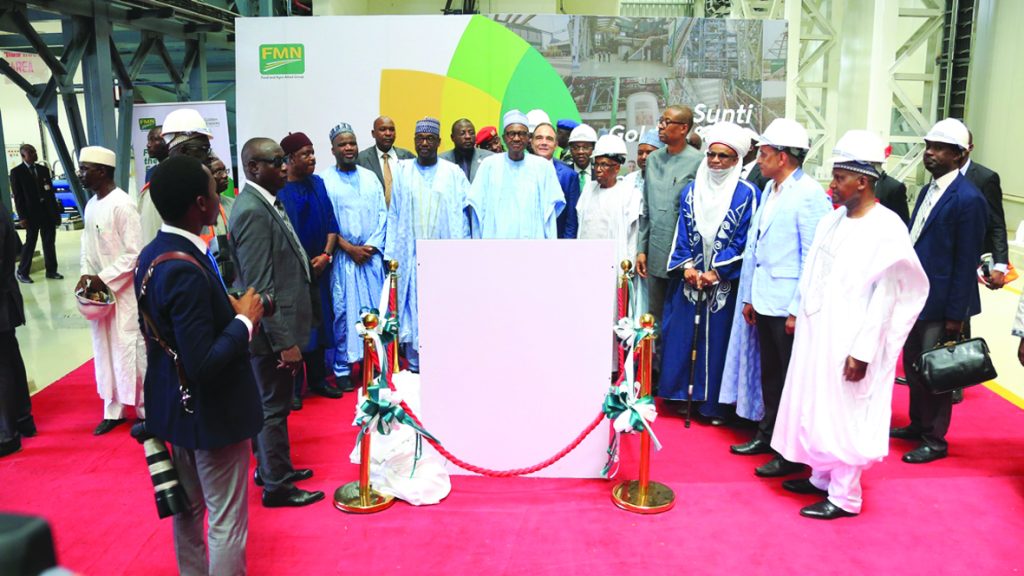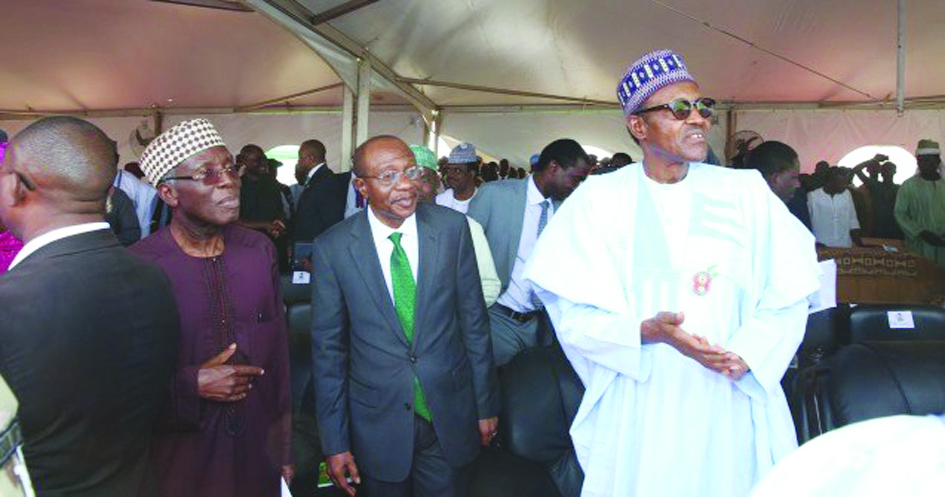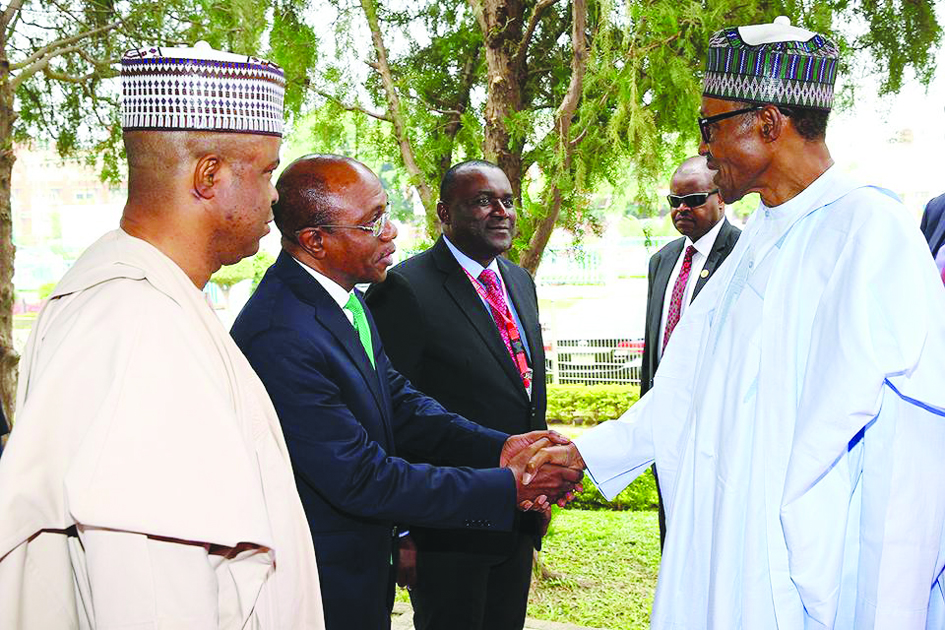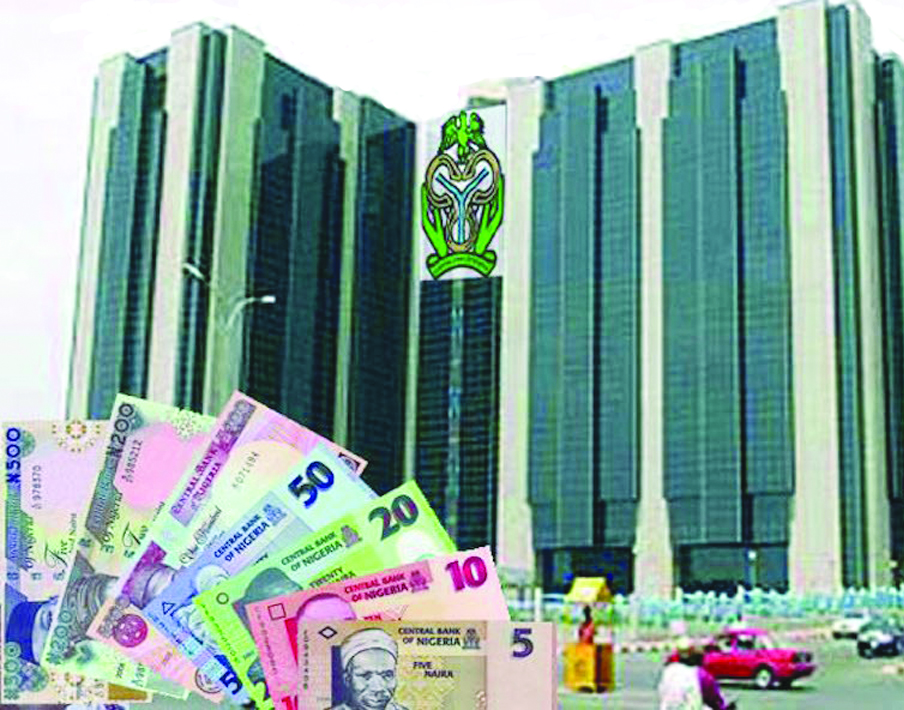IN the three years span the current administration has been in charge of Nigeria’s fortunes, the country has run the full economic circle, navigating the path of slowing growth, recession and then, growth again.
Central Bank of Nigeria (CBN) Governor Godwin Emefiele, who took the leadership mantle in June 2014, has been in the maelstrom of the tumultuous economic journey. The Bank, like had its counterparts the world over, was thrust into the lead position in the economic recovery campaign, following the 2007/8 global financial crisis and its lingering effects.
Nigeria’s situation was made even more precarious by the crash in commodity prices. Like other oil-dependent economies, the country went into shock as crude prices plummeted to record depths. The nation’s currency, the naira, was badly battered, losing value in the foreign exchange market. The ensuing instability pushed up domestic prices, increased inflation, ultimately occasioning a drastic rout of asset values.
The economy’s woes were further compounded by the ravages of Boko Haram insurgency which paralysed agricultural and commercial activities in a huge swathe of the country’s North-East region.
Not surprisingly, the country was tipped into a recession in the first quarter of 2016, with the reverberations across the country. Government went burst; sub-national entities, i.e the states and local governments could not pay wages nor their bills, provoking unrest, strikes and other disruptive social upheavals.
It was in these unsettling circumstances that the CBN, with Emefiele at the helm lunged into a series of calculated measures to bring the nation back from the brink. First and foremost was the Bank’s redesigning and restructuring of the foreign exchange market which was in total chaos. At its nadir, the naira exchanged for as high as N520 to the US dollar at the popular parallel market, all but stopping trade and commercial activities which have been the only areas that were thriving in Nigeria’s weak economy. The Bank then delved into programmes designed to boost the so-called real sector of the economy, straddling agriculture, power and transport, effectively complementing the fiscal authorities, efforts at pulling the economy out of recession and launching it once again on the path of growth.

Closure of the Retail Dutch Auction (rDAS) Window and The New Flexible Exchange Rate Regime in Nigeria
This is, arguably, the most important and impactful of the reforms the monetary authorities introduced under Emefiele’s watch. Prior to commencing the new flexible exchange rate regime, the CBN operated a managed floating exchange rate regime with a fixed band around an identified mid-point. The floating rate system was, however, challenged by the steep decline in foreign currency earnings, due to the collapse of commodity prices (particularly, oil) in the global economy starting from June 2014. This collapse was further accentuated by the persistence of militant action in the oil-rich Niger Delta area. The CBN instituted a series of exchange rate management measures to address the reduction in accretion to external reserves as oil prices declined swiftly in the second half of that year. In November, the exchange rate peg was moved from about 160 naira to 176 naira to the US$. Two months later, the Bank closed the dollar auction window (RDAS) and further devalued the naira to N196.5 per US$ at the interbank segment to ease the demand pressure building in the foreign exchange market. Further administrative measures were also carried out to help stabilize the currency.
During the periods leading to the Monetary Policy Committee (MPC) meeting of May 2016, the unsustainability of the Bank’s exchange rate management system was glaring. Dwindling oil price had significantly impacted accretion to reserves, which funded the managed foreign exchange market. In addition, the widening gaps between the official and parallel market rates increased arbitrage opportunities, undermining all efforts to stabilize rates. Against this backdrop, the MPC meeting of May 2016 therefore committed to undertake reforms to help improve the flexibility and transparency in the operation and management of the inter-bank foreign exchange market. The design of the new system was intended to allow a free float of the exchange rate to enable the naira to find an equilibrium price.
On June 15, 2016, the Bank issued guidelines for implementation of the new flexible exchange rate regime. The guidelines made provisions for a single Inter-Bank Foreign Exchange Market structure with the CBN participating in the market as one of the agents. This participation was designed to provide both demand and supply to help stabilize the value of the currency as and at when necessary. Most importantly, the Bank undertook to augment supply sources to stem demand pressures in the wider economy. The guidelines also made provisions for the appointment and registration of foreign exchange (FX) Primary dealers (FXPDs) to deal with the CBN on two-way quote basis for large trade FX transactions. Participants in the inter-bank FX market were to include Authorized Dealers, Authorized Buyers, Oil Companies, Oil Service Companies, Exporters, End-users and any other entity the CBN may designate from time to time. Transactions in the FX market would be conducted on a two-way quote basis via the financial market dealer’s quotations (FMDQ) Thomson Reuters FX Trading Systems or any other system approved by the CBN. In addition, a futures market was introduced to enable buyers and sellers hedge their exposures.
While implementation of the new flexible exchange rate regime was designed to provide greater transparency and efficiency in the management of scarce foreign reserves, the challenge of adequate supply to the market could not be overlooked as oil prices continued to drop and disruptions from the Niger Delta region remained a potential threat to supply. In the meantime, the Bank worked assiduously to close the wide gap between the interbank and parallel market rates. So far, the CBN has stabilized the exchange rate and returned sanity to the market.
Restoring Foreign Exchange Stability: The Investors’ and Exporters’ Foreign Exchange Window
The Bank introduced a new window called the Investors’ and Exporters’ (I&E) Foreign Exchange Window on April 24, 2017. It serves eligible transactions such as Bills for Collection and invisibles loan repayments, loan interest payments, remittance of dividends, capital repatriation, management service fees, consultancy fees, software subscription fees, personal home remittances and technology transfer fees etc. Before the establishment of the window, exporters and investors in small businesses were confronted with a severe crunch of foreign exchange supply. Its foreign exchange supply comes from portfolio investors, exporters, Authorized Dealers (i.e. Deposit Money Banks) and ‘other’ parties with foreign currency to exchange for naira.
To enable price discovery in the market, Authorized Dealers and their counterparties agree on exchange rates at this window for buying and selling, thus, promoting flexibility and transparency. The Financial Market Dealers Quotes (FMDQ) collates buying and selling rates and other relevant price sensitive information from the participants in the market. Trading is conducted via recorded telephone conversations, owing to the slow progress in on-boarding by corporates at the Financial Markets Dealers Quotes Over-The-Counter (FMDQ OTC) Securities Exchange, until the market migrates to a formal FX Trading platform. The expectation is that with improved transparency, key constraints which have deterred strong foreign participation in the markets, despite attractive fixed income yields will be minimized.
Allowing BDCs to buy foreign exchange directly from MTOs
On July 22, 2016, the CBN issued a circular to authorized dealers and Bureaux De Change operators on “Sales of Foreign Currency Proceeds of International Money Transfers Operators (IMTOs) to Bureaux De Change Operators”. Licensed IMTOs were mandated to remit foreign currency accruing from inward money remittances to their agent banks for disbursement in Naira to the beneficiaries while the foreign currency proceeds were to be sold directly to the Bureaux De Change (BDC) operators.
Furthermore, the Bank directed the IMTOs to ensure that foreign currency proceeds sold to BDCs which shall be retailed to end- users must be done in full compliance with extant provisions of Anti-Money Laundering Laws and other regulatory and supervisory provisions such as the Know-Your-Customer (KYC) guidelines as well as the use of the Bank Verification Number (BVN). In addition, Authorized dealers and BDC operators were expected to provide daily and weekly returns on their operations via the e-FASS application to the Director, Trade and Exchange Department of the CBN.
To curb market infractions by operators, a supplementary circular on August 9, 2016 set limits to the BDCs’ foreign exchange trading position. Authorized Dealers were also mandated to buy foreign exchange from licensed IMTOs for sale to BDCs at a margin not exceeding 1.5 per cent. Similarly, the BDCs could use the foreign exchange purchased from authorized dealers or sell to end-users at a margin not exceeding 2.0 per cent. The upshot was that BDCs were required to sell all foreign exchange purchased at a rate not exceeding 2.0 per cent regardless of the source of funds. These measures have helped to improve liquidity in the foreign exchange market and to narrow the spread in the foreign exchange market.

Restricting Access to Foreign Exchange for 41 items
Intent on conserving foreign reserves and facilitating the resuscitation of domestic industries as well as improving employment generation in Nigeria, the CBN worked on ensuring the efficient utilization of foreign exchange by restricting importers of selected goods from accessing the official foreign exchange market.
The policy was also meant to reinvigorate the capacity of Nigerian producers, reduce the country’s import bill and boost the production of basic commodities, including rice, whose importation had become a major drain on the country’s foreign reserves. The policy is expected to lead to massive job creation, improvement in the wealth of rural population, the industrial capacity and ultimately, Nigeria’s economic growth.
Over time, some macroeconomic fundamentals have performed positively. For instance, headline inflation rate has been trending downward from 18.72 per cent in January 2017 to 15.13 per cent in January 2018, reflecting, among other factors, improvement in local supply of the delisted items. Similarly, the country’s external reserves has risen significantly from US$28.56 billion in May 2015 to US$41.15 billion in January 2018 and then to $47.3billion as of April 5, this year. The last time the country’s forex reserves was at this level was in July 2013. The accretion to reserves does not only reflect increased inflow into the economy but also a relatively successful foreign exchange demand management strategy.
Direct sale of FX to Bureaux De Change
With improvement in reserves accretion, the CBN resumed selling of FX to the BDCs in 2017, effectively reversing an earlier decision to forbid it. Since then, foreign exchange availability has improved, complementing funds sourced from DMBs and Travelex. Therefore, the current stability witnessed at the BDC segment of the market is attributed to the sustained supply of foreign exchange by the CBN and other eligible economic agents.
Developments in the foreign exchange market call for coordinated approach towards exchange rate management. Hopefully, some of the gains already recorded will be sustained and in the medium to long-term, considerable improvements will be attained.
The Real Sector
To support growth in real sector activities, CBN Governor Emefiele did not only continue the Bank’s interventions programme earlier initiated but also he, introduced new programmes targeted at reviving local production and creating employment opportunities. Among these new programmes are:
Anchor Borrowers Programme:
The Central Bank of Nigeria established the Anchor Borrowers’ Programme (ABP) with a view to collaborating with well-run companies (anchors) involved in the production and processing of key agricultural commodities. The Programme is designed to help local farmers increase production and supply of feedstock to processors, reduce importation and conserve Nigeria’s external reserves. Under the Scheme, “anchor” firms serve as off-takers (buyers) in recognition of their track record and experience in working with out-growers involved in production. It brings together anchor firms, CBN, bank members of Nigerian Risk-based System for Agricultural Lending (NIRSAL) and State Governments in concert with out-growers to ensure compliance with contractual terms to reduce the incidence of side-selling.
The financing institutions under the programme serve as veritable channels for delivering credit to the out-growers. The CBN set aside the sum of N40 billion from the N220 billion Micro, Small and Medium Enterprises Development Fund (MSMEDF) for farmers at a single-digit interest rate of 9.0 per cent to fund the programme.
N300 Billion Real Sector Support Facility (RSSF)
The N300 billion Real Sector Support Facility (RSSF) was established in November 2014 to stimulate output growth, enhance value addition and engender productivity in the economy. The Facility concentrates on increasing credit to priority sectors of the economy to promote employment capabilities, high growth potential, increased accretion to foreign reserves, expansion of the industrial base and consequently, diversify the economy. It provides long-term low-interest financing solution to Nigerian SMEs with financing needs of between N500 million and N10 billion.
Accelerated Agriculture Development Scheme (AADC)
The AADC was launched in October 2017 with the objective of increasing agricultural production to enhance national food security, job creation and economic diversification. Over the next three years, a minimum of 370,000 youths would be engaged through the State Governments and the Federal Capital Territory (FCT) in agricultural production across the country

Presidential Fertilizer Initiative
The Presidential Fertilizer Initiative was launched to facilitate the local production of one million metric tonnes (mmt) of blended Nitrogen, Phosphorous and Potassium (NPK) Fertilizer for the 2017 wet season farming and 0.5 mmt for the dry season. The initiative was introduced by the Bank under the Commercial Agriculture Credit Scheme (CACS). The objectives are to:
• Make available quality fertilizer all-year round at affordable prices.
• Reduce food-induced inflation and stimulate economic activities along the agriculture value chain.
• Create jobs by revamping the 28 local blending plants (12 already producing).
• Boost savings in foreign exchange projected at US$200m.
• Boost savings in budgetary provisions for fertilizer subsidy of about N60 billion.
Nigeria Electricity Market Stabilization Facility
The CBN established the N213 billion CBN-Nigerian Electricity Market Stabilization Facility in 2014 in collaboration with the Ministries of Petroleum Resources and Power, the Nigerian Electricity Regulatory Commission (NERC) and the Nigerian National Petroleum Corporation (NNPC). This facility was aimed at settling outstanding payment obligations due to market participants, service providers and gas suppliers that accrued during the interim rules period (IRP debts) as well as legacy debts of the Power Holding Company of Nigeria (PHCN) generation companies. It is the CBN’s way of intervening to put the Nigerian electricity supply industry (NESI) on a route to economic viability and sustainability.
Nigeria Bulk Electricity Trading (NBET) Payment Assurance Facility
This is a N701 billion facility to be used to guarantee the payments due from NBET to power generation companies for the capacity and energy delivered. The programme commenced in January, 2017. So far, over 30 per cent of the amount has been disbursed to NBET. It is expected that this initiative along with others in the sector would enhance electricity supply.
Textiles Sector Intervention Facility (TSIF)
In a bid to resuscitate the Textiles Industry, the Bank put in place a N50 billion special mechanism for restructuring existing facilities and provision of further facilities to companies with genuine need for intervention in 2015. This was the result of meetings between the Bank Governor, and owners of textile mills. Textile mills were obliged to articulate the status of their Bank of Industry (BOI) CTG Loans stating their outstanding loan balances, tenure, interest rate, interest payment and the assistance being sought from the CBN. The BOI is the managing institution of this facility.
Since inception, over 50 per cent of the placed sum has been disbursed to 31 obligors/companies across the country at concessionary interest rate of 4.5 per cent for short-term loans and working capital with a tenor of up to 10 years. Turnover of the firms has improved and direct employment has increased from an average of 6,020 pre-intervention to 7,688 post-intervention representing an increase of 28%.
Building Entrepreneurial skills and enhancing credit delivery to the real sector
Committed to skills development among the country’s youths, the CBN added two new Entrepreneurship Development Centres (EDCs)) and one outreach centre to its stock of development centres. They are located in Kano (North-West), Ibadan (South-West); and Minna (North-Central), respectively. These new centres have trained 402 participants (324 male, 78 female) in North-West, 355 participants (228 male, 127 female) in South-West 342 participants (189 male, 153 female) trained in the North-Central outreach centre.
Cumulatively, from inception in January, 2015, 4,709 participants were trained under the EDCs while 2,210 jobs were created. The CBN has stimulated these and other interventions which have led to increased access to finance by farmers, entrepreneurs and other stakeholders. It is also deepening banking habits, promoting the growth of the SMEs, facilitating employment, promoting diversification of the economy and leading to income generation in the rural areas.
Financial Inclusion
In addition to the various strategies of special interventions in the economy, the Central Bank of Nigeria is also focusing on building a financial inclusion strategy for the financial services industry by implementing programmes on financial literacy, facilitating the development of mobile banking, exploring non-conventional banking models (e.g. non-interest banking) and strengthening the microfinance sub-sector. The concern of the Bank stemmed from challenges faced by small and medium size businesses in accessing credit for investment.
In most developing economies, it has been shown that financial inclusion can alleviate poverty and propel the growth. Unfortunately, however, the poor people, especially rural dwellers, are excluded from the financial system. Financial Inclusion is the delivery of financial services at affordable prices and terms to the generality of the populace, especially to disadvantaged and low-income segment of the society.
The primary objective of the strategy is to connect the unbanked population with mainstream financial services. The CBN is committed to sustain its effort at achieving the objective of raising financial inclusion to 80 per cent by 2020. To achieve this target, the Bank has new products to improve service delivery channels to women, youths and people living with disabilities. In June 2015, the Financial Literacy Working Group (FLWG) was inaugurated. It is a combination of three working groups that existed under the Legacy Financial Literacy Steering Committee. They include: Mass Sensitization, School Reach-out and Curriculum Development.
Reflating the Economy out of Recession
In the past couple of years, the Bank has been providing support to financially-stressed State Governments by way of bail-outs to enable them to pay salary arrears owed to public servants. The initiative of the Bank spurred aggregate demand, thus reflating the economy.
Association of African Central Banks (AACB) Collaboration with the European Central Bank (ECB) and the Federal Reserve Bank of New York (FRBNY
Mr Emefiele became the Chairperson of the Association of the African Central Banks (AACB) during the 39th ordinary meeting of the assembly of governors held in Nigeria in August 2016. During his tenure, the AACB entered into non-binding agreements with the ECB on capacity development.
Under his chairmanship, the ECB actively participated in the 2017 AACB meeting where the CBN made a presentation that highlighted the participation of the ECB in past AACB events, as well as the aim of the cooperation between the two organizations.
Similarly, the AACB under Governor Emefiele’s chairmanship has established collaboration with the Federal Reserve Bank of New York (FRBNY). The FRBNY recalled in particular the need to better appreciate dynamics in cross-border flows of capital and goods in the increasingly interconnected global economy and financial markets, the importance of African countries representing approximately one-quarter of the total number of FRBNY’s foreign official accountholders, and the need for stronger dialogue on the evolving risk environment in cross-border payments.
In moving forward to strengthen the global financial system, the FRBNY stands ready to develop stronger relationships with African central banks. Its participation in the AACB meetings is viewed as the first step in that process and the FRBNY’s readiness to commit to a more comprehensive and sustained engagement with the AACB going forward.


